Latinx Files: This one’s for the Latina gay icons
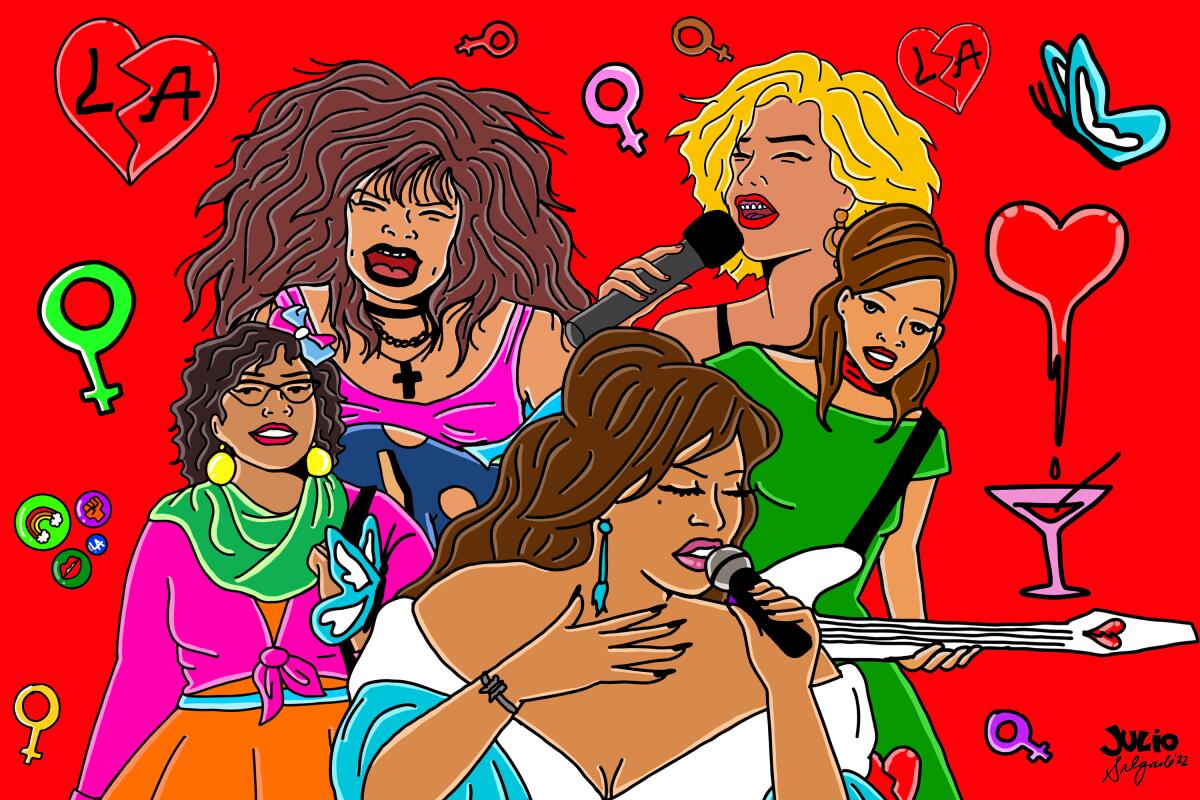
- Share via
Quiubo gente!
Every once in a while, we like to turn the main story of the newsletter over to a guest writer or illustrator. The idea is to include as many voices in the Latinx Files as possible. This week, we have a guest writer and illustrator.
Julio Salgado is a visual artist based in Long Beach. His work has been displayed at the Oakland Museum, SFMOMA, and Smithsonian American Art Museum. He also illustrated the newsletter we did celebrating Juan Gabriel’s legacy. To see more of his work, go to juliosalgadoart.com. Take it away, Julio!
A few years ago, my best male friend Jesús — a heterosexual man — asked me why gay men love to listen to female singers. I rolled my eyes because his inquiry was based on a generalization.
One that happens to be true.
The closest answer I could offer was that a lot of gay men feel seen in songs about falling for a guy that you know isn’t good for you, or in songs about female empowerment in a straight white male-dominated world.
I can’t speak for the other gays of the world, but me and my close group of gay friends just prefer female singers. The music from the following Latinas has been in constant rotation in my CD players, iPod nanos, and now on Spotify Music playlists. These singers have given me music that has gotten me through some emotional times.
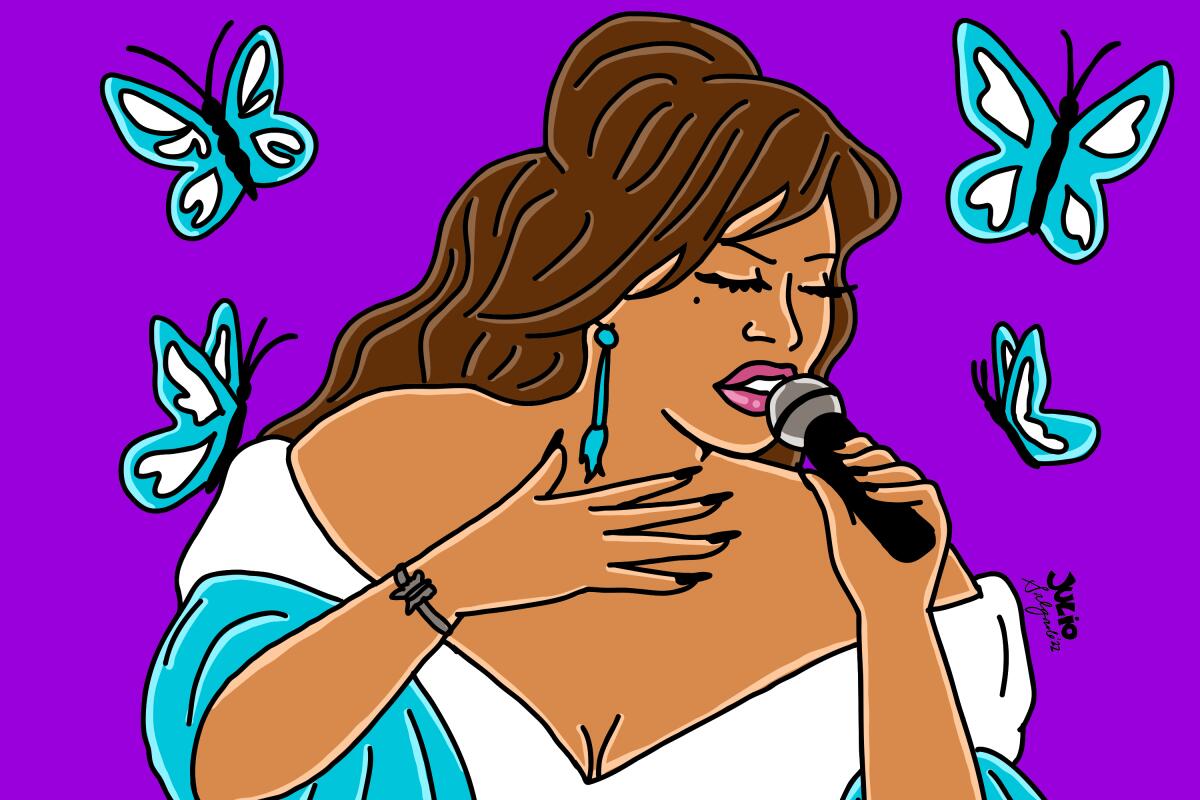
Jenni Rivera
I’ll start with my personal favorite gay icon, Jenni Rivera.
In the early 2000s, Latinx audiences outside of her native (and mine) Long Beach got to know her because of her national Spanish-language TV performances and interviews.
Fans were in awe of her backstory. She was a struggling single mother trying to make it in the mostly male-dominated banda and Norteña music scene, belting out songs like “La Chacalosa” all over Southern California nightclubs. Since then, songs like “Querida Socia” and “Ya Lo Sé” have become classics.
Funny enough, the only time I actually got to see her perform live was during the Irvine stop of the 2010 Lilith Fair revival. I remember the Mexican gays and señoras in the audience went out of their way to show their love by screaming back every single word that Jenni belted out from the stage.
I never got to see her perform again. She died in a plane crash in 2012. But every time I see a drag queen perform a Jenni Rivera number at the New Jalisco bar or Tempo, I am taken right back to that 2010 concert.
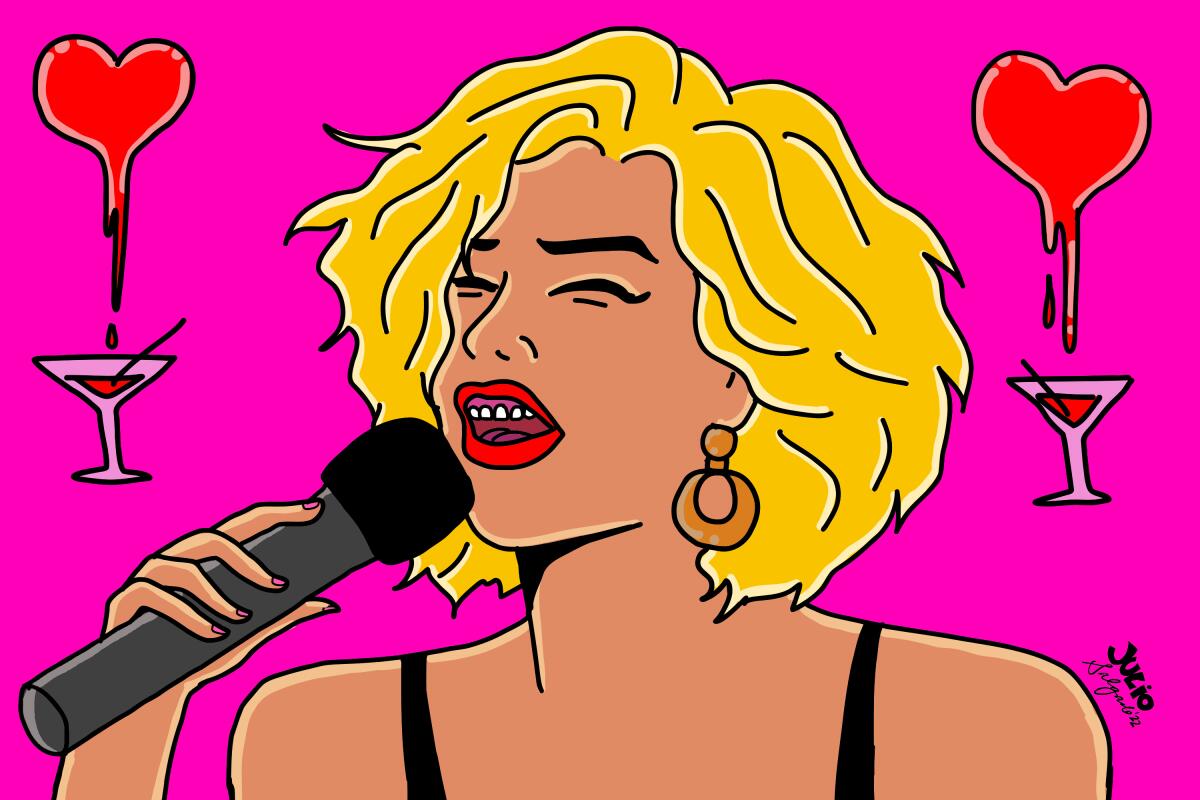
Marisela
In August 2018, me and a group of my closest gays and homegirls rolled up to the Microsoft Theater to see one of our favorite heartbreak singers: Marisela.
Nobody sings songs about secret love affairs and men that leave better than her.
“Marisela has been a gay icon because of the emotional rawness in her art,” said Jorge Gutierrez. An undocumented and queer activist, Gutierrez was among the friends who went with me to see “La Dama De Hierro.”
Perpetually clad in tight miniskirts and messy blonde hair, Marisela was a staple on “Siempre En Domingo,” the Televisa variety show that made or broke the careers of Latin American pop stars throughout the ’70s, ’80s, and ’90s.
The Latinx experience chronicled
Get the Latinx Files newsletter for stories that capture the multitudes within our communities.
You may occasionally receive promotional content from the Los Angeles Times.
It wasn’t until I had my first real heartbreak in college that I truly understood what she meant when she sang “Sin él / Se ha acabado el camino / Y ahora no se a donde ir.”
Jenni Rivera was actually a huge Marisela fan. In 2009, she surprised Rivera on stage while la diva de la banda performed a cover of “A Escondidas.” Back at the Microsoft Theater and after way too many Patron shots, I drunkenly sang along to that same song with my gays and my homegirls, cursing every man that broke our hearts.

Gloria Trevi
One of my all-time favorite Gloria Trevi performances is her infamous 1989 debut in “Siempre En Domingo.” I’m serious when I say that show made and broke careers because she actually got banned from Televisa after her so-called raunchy performance got her in trouble with the powers that be. I don’t remember seeing this specific performance when I was a little kid, but I’ve seen it a million times on YouTube.
In the early ’90s, little girls and gay boys all over Latin America lip-synced into hairbrushes to Gloria Trevi classics like “Pelo Suelto” and “Zapatos Viejos.” She was a star.
That all changed in 2000 after she and her manager were arrested for allegedly kidnapping and abusing underage girls. Trevi spent four years in jail before she was acquitted of all the charges.
At the 2018 Latin AMAs, in the wake of the #MeToo movement, Trevi opened up about the incident and shared her own story of being physically and emotionally abused by the same manager starting when she was only 15 years old. When she tried to reignite her career, it was Gloria Trevi’s gay fans who were quick to embrace the fallen star. When it came time to put out a video for her 2006 hit “Todos Me Miran,” she acknowledged the continuous support from the LGBTQ+ community by centering the story of a trans woman facing Mexican society.
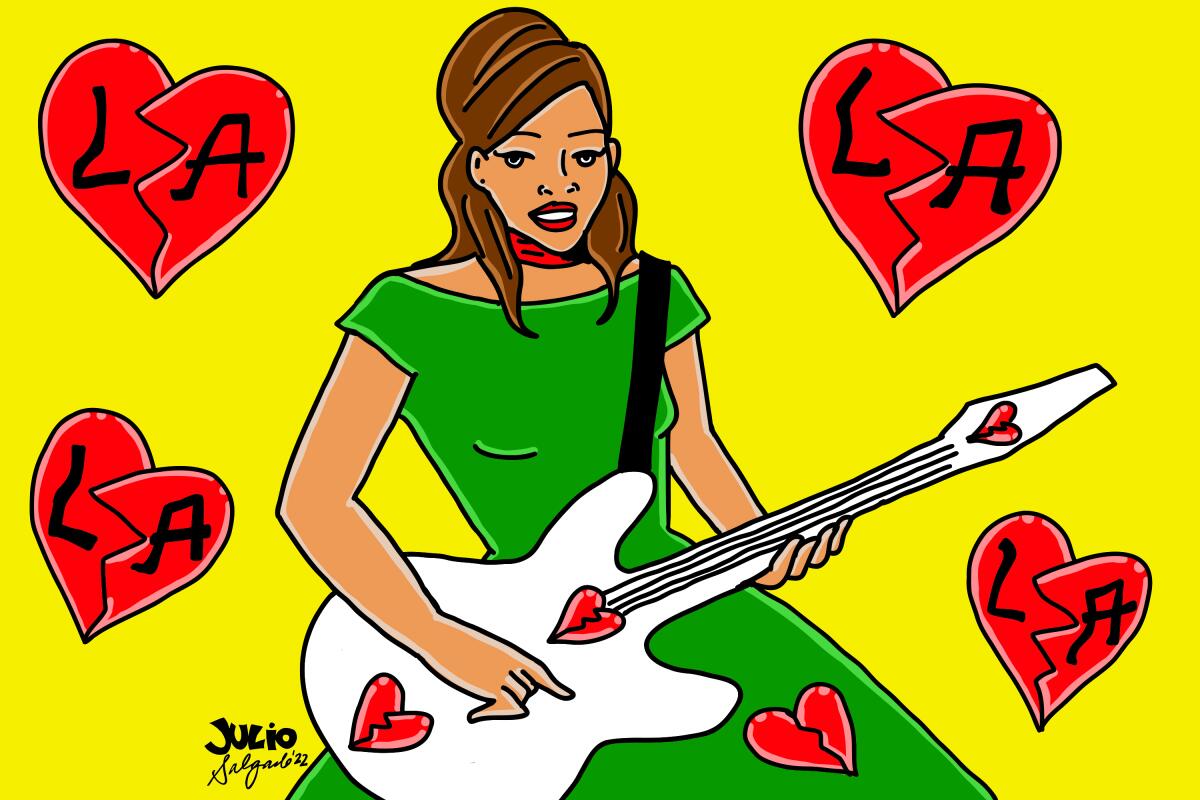
Pilar Diaz from Los Abandoned
During my community college years, I balanced pop hits being played all over WeHo nightclubs with some of the best alternative Latinx music coming out of places like La Cita and the Echo.
One of my favorite bands from that mid-2000s scene was Los Abandoned, led by the amazing Pilar Diaz. It made me happy to see that “Van Nuys (Es Very Nice)” was rightfully included in the Times’ “50 Songs for A New L.A.”
I was such a fan that for a while, I was part of their street team. At every single show, there was always a group of us queers jumping up and down to songs like “Me Quieren En Chile” and “Stalk U.”
“My goal is that I want people to feel free to be themselves,” said Diaz of her band’s LGBTQ+ fans. “People felt that they could be themselves through our music. Back then we weren’t necessarily thinking of ‘safe space,’ but it was naturally like that.”

La Marisoul from La Santa Cecilia
When I was about to drop out of college just a couple of semesters short of graduating due to lack of funds because of my undocumented status, my friends put together a fundraiser show. They hired a then-little-known band called La Santa Cecilia.
That’s right! Before they were Grammy-award winners and becoming an international sensation, my friends and I got to see La Santa Cecilia perform in my parent’s small living room in Long Beach!
I became an instant fan, and helped pack the dance floor at La Cita with other fans whenever I could.
“I feel super grateful for the love of the queer community because this is the people I grew up with,” said La Marisoul.
“I’m bisexual and I’ve been in love with women, and I’ve come out to my parents. The spaces that we play is for all of us weirdos and queer kids that love all kinds of music. Music is my superpower!”
La Marisoul and La Santa Cecilia have also used their popularity to speak up in support of undocumented community. Their song “ICE El Hielo” is arguably one of the best songs about the plights that we face as undocumented immigrants in the U.S.
Consider subscribing to the Los Angeles Times
Your support helps us deliver the news that matters most. Become a subscriber.
Gustavo & El Sheriff
Hi folks. It’s Fidel again.
Columnist Gustavo Arellano recently interviewed Los Angeles County Sheriff Alex Villanueva. The sit-down was originally supposed to focus on the department’s Latinx numbers but turned into a three-part series in which Villanueva sounds off on a list of grievances.
The series is a very sobering read. It’s terrifying that a man in charge of the largest sheriff’s department in the country espouses such anti-Black and racist views, and has no qualms saying them out loud.
It’s also concerning that the sheriff isn’t an outlier when it comes to that way of thinking.
“That’s when I realized Villanueva was even more Latino than I gave him credit for,” wrote Arellano. “He had tapped into the vein of anti-Blackness latent in all Latinos, one that gets exacerbated when Black and Latino communities compete for the same resources in the United States.”
Things we read this week that we think you should read
— Many congratulations to Ariana DeBose, the first openly queer woman of color to win an Oscar in an acting category. DeBose, who identifies as Puerto Rican and as an Afro Latina, portrayed Anita in the Steven Spielberg remake of “West Side Story.” The character also won Rita Moreno an Academy Award in 1962.
“Anybody who’s ever questioned your identity ever or find yourself living in the gray spaces? I promise you this. There is indeed a place for us,” DeBose said during her acceptance speech.
Congrats also to Latinx generational trauma, which took home the Academy Award for Best Animated Feature.
— And speaking of commendations, felicidades to Laurie Ochoa and Daniel Hernandez for being named the general manager and editor of the food section, respectively.
Why is this a big deal? My colleague David Carrillo Peñaloza said it best:
— Here’s something cool: Refinery29 has launched “Cuerpo,” a collection of stories and first-person narratives that explore the relationship Latinxs have with their bodies.
— In case you missed it, Jean Guerrero wrote about how she’s spent much of her life Anglicizing her name and her journey in reclaiming her heritage and Spanish pronunciation. Guerro’s column is honest and vulnerable, delving into the perils/pitfalls of white adjacency and the internalized shame many feel because of it.
— Feel like having a good cry? Then you should absolutely read the latest Column One by Soudi Jiménez. Make sure to have some tissues handy.
And now for something a little different...
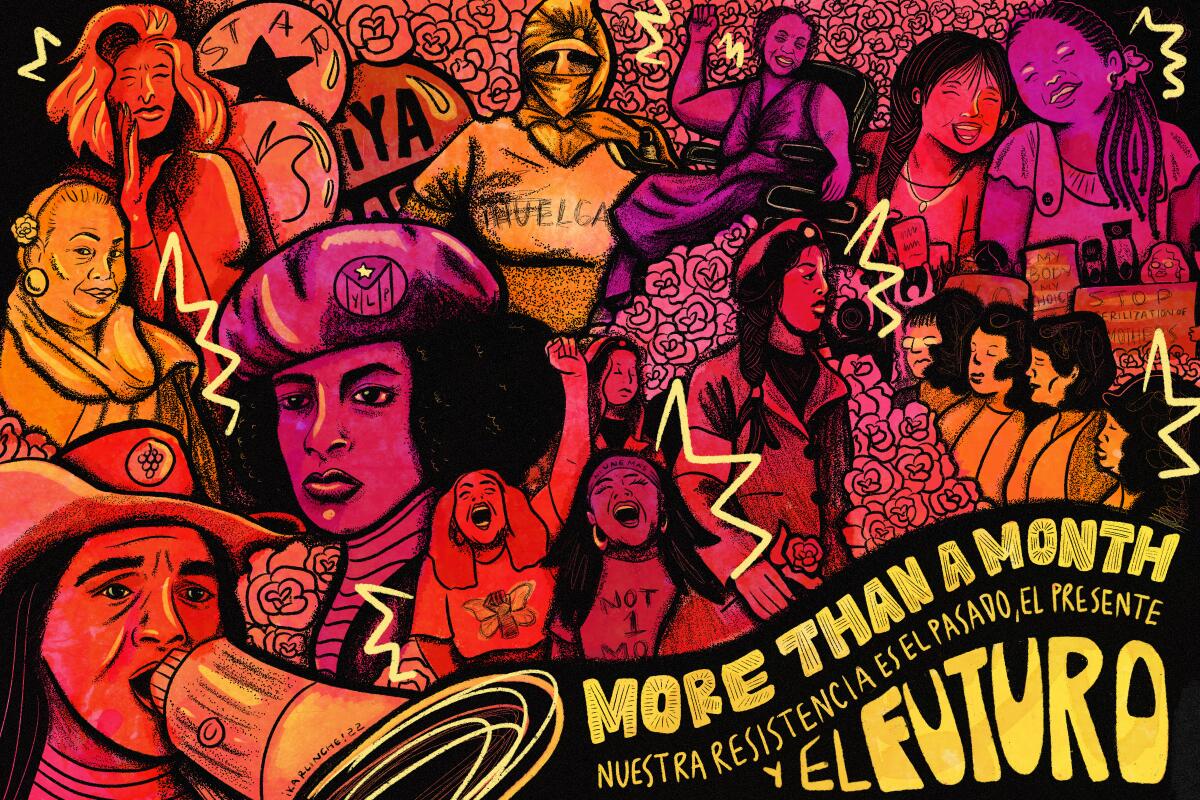
Karla Rosas is KARLINCHE, a DACAmented illustrator and painter from Mexico who is based in New Orleans. Karla’s art explores the ways that immigration, the border, and illegality shape experiences of family history, queerness, mental illness, the body, and self-identity. Currently, Karla is working on a collection of illustrated prose titled “Desahogando: an Undrowning.”
“I recently visited L.A. with my mother and sister, and we got to experience the ‘Patriotism in Conflict’ exhibit at La Plaza de Cultura y Artes. Being there with my mom and sister had me reflecting on the role women have had in shaping U.S. history, specifically working class Latine women of color. So I wanted to draw something that honors some of my favorite U.S.-based Latine women movement makers and history shapers — including Lorena Borjas, Sylvia Rivera, Dolores Huerta, the women of the Brown Berets and the Young Lords, Engracia Figueroa, and Puerto Rican and Mexican mothers who fought against forced sterilizations by the government. When we confine women’s histories to one month, we minimize their contributions to all of our histories and all of our futures.”
Are you a Latinx artist? We want your help telling our stories. Send us your pitches for illustrations, comics, GIFs and more! Email our art director at martina.ibanezbaldor@latimes.com.
The Latinx experience chronicled
Get the Latinx Files newsletter for stories that capture the multitudes within our communities.
You may occasionally receive promotional content from the Los Angeles Times.






